► VW ID.3 and Cupra Born driven in UK
► Which should an enthusiast choose?
► We do the hard work for you
The pisstaking is relentless. The Born has just turned up and my colleagues are tearing it a new one. ‘It looks like a B&M Batmobile’ is my favourite gibe of the day. I have to admit, they have a point.
The matte grey and copper accents have more than a whiff of Live, Laugh, Love about them. From the front it looks aggressive but the side is pure ID.3. The rear, too, has more than a hint of VW to it.
Inside it’s even more coppery (picture below). The steering wheel of course, has the bronzed Cupra badge, but the vent controls storage slider are also subject to a dose of ginger hair dye. Stitching too.
It’s not that it doesn’t look good, it’s just that it’ll age horribly. The different materials used throughout, many of which are recycled according to Cupra, make it look as though the designeers couldn’t stop fiddling with it to attempt to make it look different to the ID.3.
Both cars get similar touchscreen infotainment setups, although at 12 inches, the Cupra’s is larger by a couple of inches. They both have the same driving binnacle atop of the steering wheel and the same fiddly/innovative twist gear selector.
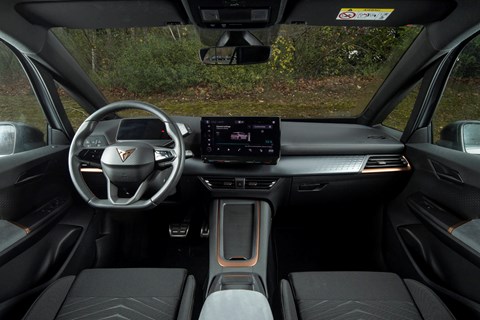
Oddly the ID.3 has a drive mode select shortcut on a separate touch sensitive ‘button’ beneath the infotainment screen, whereas the Cupra doesn’t. This means it takes two clicks to get Sport mode in the VW, but in the Cupra it can be a multiple prod jobbie.
The ID.3 is my long-termer. I’m completely used to the looks. There are loads around me in North London and I think it’s a handsome thing. I especially love the turquoise paint. The lack of wheel trims is a personal choice. I think it looks cool on steelies. And I am also aware that not getting alloys on a £40k car will seem obtuse to many.
I will say there is a palpable difference between the Cupra and ID.3 interiors. The ID.3 is a lot simpler, with some cheaper looking plastics and absolutely no copper. Multiple non-car nerds have commented on how basic the ID.3 interior feels and looks. I don’t think they’d say the same about the Cupra.
What trim levels are you reviewing?
The Born on test is a left hooker. It’s the equivalent of a V2 trim level, which is mid-range in Cupra speak.
The ID.3 is a Max Pro performance, which is one below top.
Both cars have the same 58kWh/201hp/229lb ft electric motor hooked up to a single-speed auto powering the rear wheels. Both have a 7.3second 0-62mph time and both have a WLTP range of 260 miles, and therefore a real world range of around 200 miles.
And of course, you’re looking at the same charging times. About 30 minutes on a rapid charger from 5-80%.
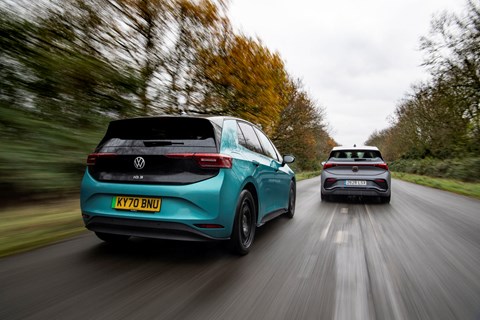
What’re they like to drive?
I know what you’re thinking. There hasn’t been a RWD hot-hatch since the BMW 1-Series became front/four-wheel drive. Unfortunately, Cupra hasn’t been bold enough to fill in this gap.
It’s not that the Born is particularly slow. It’s just not that much fun. And importantly, it doesn’t feel all that different from the ID.3.
Hardware differences between Born and ID.3 include bigger wheels (20-inch v 18-inch), wider tyres, and the Cupra being 10mm lower at the front and 15mm lower at the rear.
Apparently the ESC is turn off-able in the Born. While I found the option, I still think it kicks in. Even on a miserable and wet December day in the Midlands, I could only squeeze a slight wiggle from the rear before the car’s brain kicks in
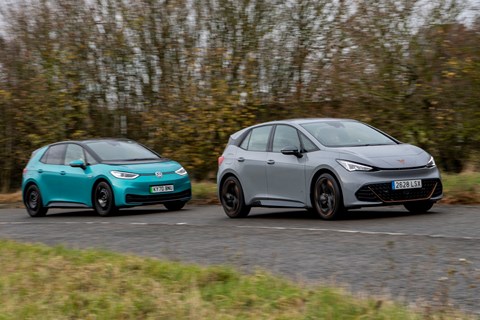
I hand the Born to a more committed member of staff. Watching from the ID.3 I can confirm that when the Born gets to a certain angle power just stops abruptly and things are kept in check.
The ID.3 doesn’t have an ESC off mode and broadly behaves in a very similar way, with perhaps a bit less slip.
Both cars feel heavy. There’s no getting round the fact that the batteries weigh 350-ish kg and both still roll considerably in the corners.
Crucially, they each ride really really well. This is especially impressive for the Born. Our test car is riding on 20-inch wheels and the damping feels superb. It’s springy, forgiving and only a few imperfections are translated into the cabin.
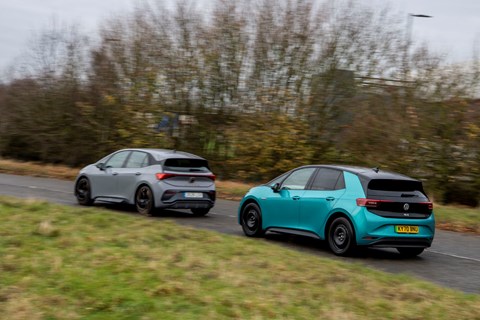
Driving them back-to-back over the same route reveals the Cupra is a bit stiffer and the steering is a touch weightier. But I’d be hard pressed to tell the difference between the pair if I hadn’t literally got out of one and into the other.
As with most electric cars, acceleration from 0-30 is impressive, but both do tail off after this. Sport mode on each car, dials things up a bit and the response is impressive.
Both Cupra and VW have rear drums. EVs usually don’t ‘need’ rear discs because of all the regenerative braking. But I can’t help but feel a bit more braking bite would be appreciated in both of them.
Verdict
I think the sort of person who’d enjoy a copper accented car would prefer an Audi badge. Don’t get me wrong. As a car I think the Cupra works. It’s comfy, practical and the range is good enough. But as a hot-hatch it’s flawed. It just never feels that fast or fun. It never grabs hold of your nether regions and drags you out for a drive.
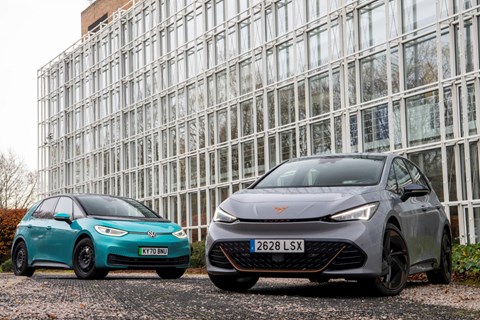
If you’re the kind of person who likes M-Sport, S-Line, or AMG-Line, this Cupra Born could be for you as it offers all the looks without any of the setbacks or thrills of anything actually fast.
But if you’re just looking for a sensible electric car the VW is the way to go. If you lust after a battery powered hot-hatch, there still isn’t anything on the market for you.
Photography by Stuart Collins
Cupra Born VZ2 (as tested)
|
Price when new:
|
£35,000 (est)
|
|
On sale in the UK:
|
Early 2022 |
|
Engine:
|
Electric motor, 201bhp, 229lb ft
|
|
Transmission:
|
Single-speed, rear-wheel-drive
|
|
Performance:
|
7.3sec 0-62mph, 99mph, 260-mile range
|
|
Weight / material:
|
1749kg
|
|
Dimensions (length/width/height in mm):
|
4322/1809/1540
|
VW ID.3 Max Pro Performance (as tested)
|
Price when new:
|
£39,500
|
|
On sale in the UK:
|
Now
|
|
Engine:
|
Electric motor, 201bhp, 229lb ft
|
|
Transmission:
|
Single-speed, rear-wheel-drive
|
|
Performance:
|
7.3sec 0-62mph, 99mph, 260-mile range
|
|
Weight / material:
|
1719kg
|
|
Dimensions (length/width/height in mm):
|
4261/1809/1552
|